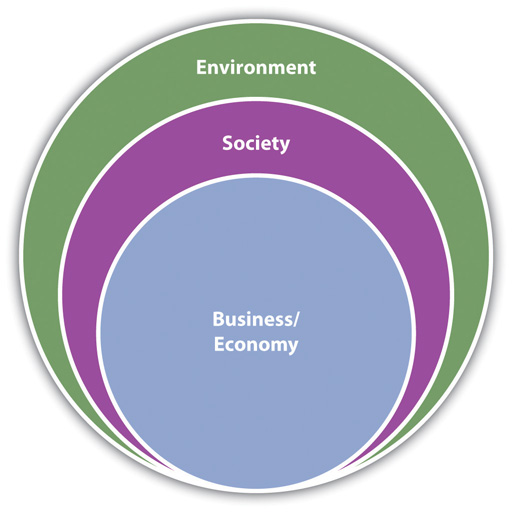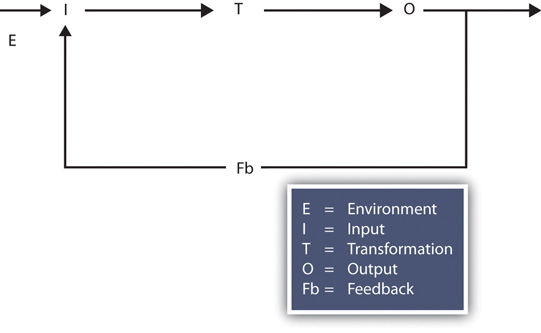This is “What Is Required for a Sustainability Perspective?”, section 1.4 from the book Sustainable Business Cases (v. 1.0). For details on it (including licensing), click here.
For more information on the source of this book, or why it is available for free, please see the project's home page. You can browse or download additional books there. To download a .zip file containing this book to use offline, simply click here.
1.4 What Is Required for a Sustainability Perspective?
Learning Objectives
- Be able to explain what is required to have a sustainability perspective.
- Understand what it means to have a systems perspective.
- Describe why a systems perspective is useful for guiding sustainable business practices.
Sustainability and managing a business that works to contribute to sustainability requires a different perspective than many businesses currently have. Most businesses focus on profits, often with a short-term, annual, or even month-to-month focus. Sustainable business practices require a longer term and a systems perspective on how a business organization’s actions impact the environment and society. It requires business managers being mindful and considering not only the traditional business concerns, such as revenues, costs, and profits, but also the effects their actions have on the physical environment and the well-being of future generations.
A systems approachSystems are made up of components that work together for the overall objective of the whole. The systems approach is simply a way of thinking about these total systems and their components. can provide an important perspective on sustainability matters.C. West Churchman, The Systems Approach (New York: Delacorte, 1968). Societal well-being and the sustainability of societal resources are interrelated and relevant for individual businesses and industries as well as for individuals, cities and towns, nations, and the entire planet. For example, on a local community scale, a resource-dependent community economy (e.g., a fishing community in Newfoundland, Canada) cannot achieve economic sustainability if it depletes its most valuable local natural resource—fisheries. On a global scale, global economic activity (by all individuals, households, and businesses collectively) that contributes significantly to greenhouse gas emissions and global warming cannot be sustained if natural resources and human population and health are adversely affected and not sustained.
Starting with the most simple systems perspective we can consider the interdependence between a single company and society as taking two main forms. Every firm impacts society through its operations in the normal course of business—for example, McDonald’s with its packaging and BP with its oil drilling. These are called “inside-out” linkages.Michael E. Porter, Competitive Advantage: Creating and Sustaining Superior Performance (New York: Free Press, 1985). Then there are “outside-in” linkages with external environmental and societal conditions influencing businesses. For example, McDonald’s depending on the supply of food and BP depending on the oil supply.
Another way of thinking about this system is to first think about the consequences of business, for example, how each business affects the economy, the natural environment, and the people (e.g., consumers and employees), and then to think about the context in which businesses operate in, including the natural, human, and social resources businesses depend on to operate and the legal and regulatory context businesses operate in. Systems thinking would have businesses be mindful and considerate of their operating context and consequences. And systems thinking could help business managers consider how the consequences (outcomes) of their activities affect the context in which they operate in the long term. So for example, if a timber company is depleting a forest it owns, it can think about how this will affect its operating context including its supply costs in the future.
Business’s Place in Larger System: A Simple Depiction
Business and the economy are an important part of the greater social system. Businesses and the economy exist within a broader system of laws, cultures, and customs that make up human society. The global social system exists within the broader context of the earth’s environment. Businesses, the economy, and society are dependent on the earth’s natural resources.

A more complex and dynamic systems approach or perspective defines a system as a set of things that affect one another within an environment and form a larger pattern that is different from any of the parts. When viewed from a systems perspective, organizations engage in the continual stages of input, throughput (processing), and output in an open or closed context. A closed systemIn a systems approach context, an organization that is isolated from the external environment. does not interact with its environment. It does not take in information and therefore is likely to atrophy—that is, to vanish. An open systemIn a systems approach context, an organization that continually interacts with its external environment. receives information, which it uses to interact dynamically with its environment. Openness increases the likelihood of survival and prosperity.
Sustainable business practices require an open systems perspective and consideration of how business actions impact not only internal operations and outcomes (such as costs, sales, and profitability) but also external outcomes—that is, the environment and the sustainability of the natural and social systems that businesses are part of.
Systems Conceptual Model

Source: A. H. Littlejohn and S. Cameron, “Supporting Strategic Cultural Change: The Strathclyde Learning Technology Initiative as a Model,” Association of Learning Technologies Journal (ALTJ) 7, no. 3 (1999): 64–75.
All the systems perspectives highlight how businesses are part of a larger system, and they all suggest the importance of businesses—as major components of the US social and economic system—being mindful and taking into consideration how their activities affect the larger system.
Key Takeaways
- Sustainable businesses require a systems perspective.
- The systems perspective enables businesses to understand their position and relationship in the larger environmental and social system, including their dependence on inputs and how their output and use of resources affects the overall system and the elements of the system.
- Without a systems perspective, businesses would not be able to understand their impact on society and the environment.
Exercises
- Do you agree or disagree with the statement “an open system is sustainable while a closed system is not”? Come up with specific examples to support your assertion.
- In your own words, define what is meant by outside-in linkages and inside-out linkages in a business context. Provide a specific example of each type of linkage.




